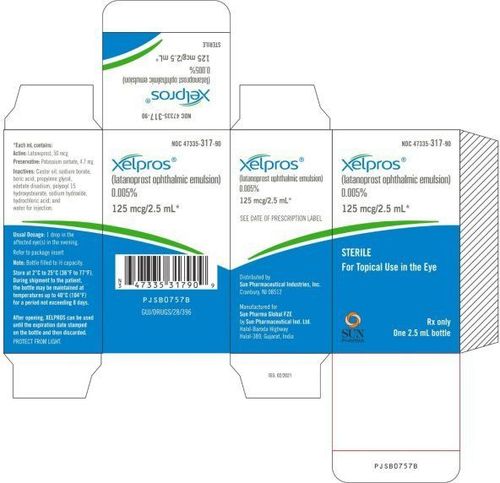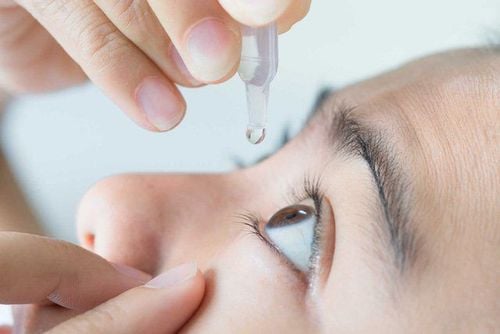This is an automatically translated article.
The combination of an antibiotic and an active corticosteroid is very common, most commonly found in eye drops such as Blephamide. So what is Blephamide and what does Blephamide do?
1. What is Blephamide?
Blephamide is a combination of antibiotic and anti-inflammatory corticosteroid eye ointment with specific ingredients including:
10% Sulfacetamide sodium antibiotic; Prednisolone acetate concentration 0.2%; Excipients: Phenylmercuric acetate 0.0008%, mineral oil, alcohol and Lanolin;
2. What does Blephamide do?
Prednisolone in Blephamide has anti-inflammatory effects caused by a variety of agents and may slow wound healing. Corticosteroids interfere with the body's defense against infection, thus requiring the use of an additional antibiotic for the anti-inflammatory effect to be clinically meaningful.
The combined use of Corticosteroids and antibiotics has the advantage of increasing the patient's adherence to treatment and is more convenient, but the combination of drugs must ensure that the dose of both active ingredients is appropriate and at the same time. ensure compatibility between components. The antibiotic Sulfacetamide in Blephamide has a bacteriostatic effect, which works by inhibiting the synthesis of folic acid necessary for bacterial growth through competition with P-Aminobenzoic Acid. However, some susceptible strains of bacteria may still be resistant to Sulfacetamide by various mechanisms. The antibiotic component Sulfacetamide in Blephamide has in vitro activity against susceptible strains of bacteria such as Escherichia coli, Staphylococcus aureus (staphylococcus aureus), Streptococcus pneumoniae (pneumococcal), Streptococcus (group of viridans), Haemophilus influenzae, Klebsiella and Enterobacter. However, Blephamide is not effective against bacterial strains such as Neisseria, Pseudomonas and Serratia Marcescens.
3. Indications and contraindications of Blephamide
Blephamide is indicated for corticosteroid-responsive inflammatory eye conditions, superficial bacterial infections of the eye, or for the prophylaxis of high-risk eye infections. Corticosteroid eye drops are indicated for the purpose of reducing inflammation in cases of inflammation of the conjunctiva, serosa, cornea and anterior portion of the eyeball because these sites may accept the risks of corticosteroid use. . Corticosteroid eye drops are also indicated in chronic anterior uveitis and corneal damage caused by chemicals, radiation, thermal burns or foreign bodies.Contraindications of Blephamide:
Most viral keratitis and conjunctivitis, including herpes simplex keratitis (dendritic keratitis), Vaccinia virus infection, chickenpox, mycobacterium infection or fungal infection of the eye ; Blephamide is also contraindicated in patients with a history or background of allergy to any of the ingredients in the drug, to sulfonamides and other corticosteroids.
4. Dosage, how to use Blephamide
Patients should each time use 1 drop of Blephamide in the eye, 2-4 times / day depending on the severity of the disease. Usually in the early or acute phase of blepharitis, Blephamide provides rapid effect when instilled directly into the eye, with a wide spread over the eyelid. However, in the case of only the eyelids, the patient can apply Blephamide directly to the affected area.
Patients can reduce the dose of Blephamide, but be careful not to stop treatment too soon. In some chronic conditions, patients may be able to discontinue Blephamide by gradually reducing the frequency of instillation. If signs and symptoms do not improve after 2 days of Blephamide instillation, the patient should be reevaluated by a physician.
5. Some warnings when using Blephamide
Prolonged use of corticosteroid eye drops may lead to posterior subcapsular cataracts and glaucoma in susceptible individuals, possibly with optic nerve damage and visual impairment.
If Blephamide is used for 10 days or longer, patients should have their intraocular pressure checked regularly, although this can be difficult in children and uncooperative patients.
The use of steroids (including Blephamide) after cataract surgery may slow healing and increase the incidence of puffiness.
Cases of corneal or scleral thinning, complications of perforation have been known to occur with the use of topical corticosteroids.
In acute eye infections, corticosteroids may mask an infection or increase the extent of an existing infection.
The use of Blephamide may prolong treatment and worsen many viral eye infections (including herpes simplex). Therefore, the use of Blephamide in the treatment of Herpes simplex requires special caution.
Prolonged use of Blephamide can suppress the body's resistance and increase the risk of secondary eye infections. At the same time, prolonged use of topical antibiotics can lead to the development of resistant strains of microorganisms, including fungi.
Acute anterior uveitis can occur in susceptible individuals, mainly blacks.
Death has been reported, albeit rarely, from a serious reaction to sulfacetamide in Blephamide associated with Stevens-Johnson syndrome, toxic epidermal necrolysis, fulminant hepatic necrosis, leukopenia granulomatous, aplastic anemia and other blood disorders.
6. Some precautions when taking Blephamide
The appointment of the drug Blephamide and prolongation of the drug is done by the doctor only after examining the patient's condition with the help of imaging methods. If signs and symptoms do not improve after 2 days of Blephamide administration, the patient should be reevaluated.
The possibility of a fungal infection of the cornea should be considered after prolonged use of Blephamide, in some cases requiring a fungal culture for diagnosis.
Blephamide medicinal products are manufactured completely sterile. To avoid contamination, the patient should take care to avoid touching the tip of the tube to the eyelid or any other surface during application. Also do not use a single vial of Blephamide on more than one person and keep the cap tightly closed when not in use.
Blephamide should be used during pregnancy only if the potential benefit outweighs the possible risk to the fetus.
Use of Blephamide in Lactation: Because of the potential for serious adverse reactions in nursing infants from Blephamide, the mother should decide whether to discontinue nursing or discontinue the drug after evaluate the effectiveness of treatment with this product.
7. Blephamide side effects
Common side effects of Blephamide include:
Cataracts; Dizziness , Eye discharge; Eyelid edema; Erythema of the eyelids; Eye irritation; Eye pain, itching, and hypersensitivity manifestations include rash, pruritus, urticaria, ocular congestion, and visual disturbances. The above are not all side effects of Blephamide. Therefore, during use, if you experience any unusual symptoms, you should notify your doctor for timely advice.
Please dial HOTLINE for more information or register for an appointment HERE. Download MyVinmec app to make appointments faster and to manage your bookings easily.













